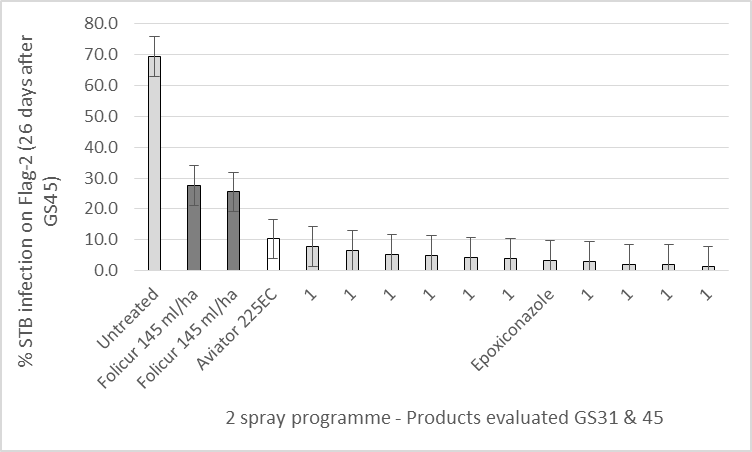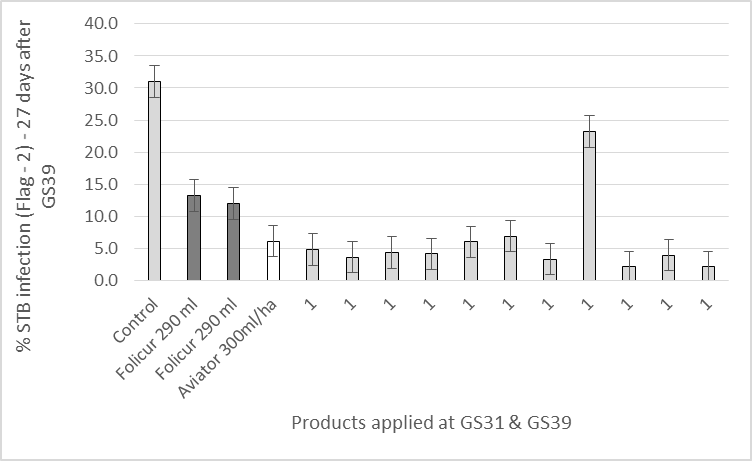New and emerging disease management options in barley
Author: N. F. Poole and T. Wylie, Foundation for Arable Research (FAR) Australia | Date: 01 Mar 2016
Take home messages
- Fungicides with new modes of action, such as the Succinate Dehydrogenase Inhibitors (SDHI’s - FRAC Group 7) are now being commercialised in the Australian market.
- Initial results with the SDHI’s have been very promising against a range of barley diseases such as net blotches and scald as well as wheat diseases such as yellow leaf spot and Septoria tritici blotch (STB).
- The SDHI fungicides are at a moderate to high risk of pathogen resistance development so it is imperative that we don’t overuse these products and adhere to anti resistance guidelines.
- As more evidence of fungicide resistance (or insensitivity) in triazoles emerges it emphasises the need to use fungicides as part of an Integrated Disease Management (IDM) approach that capitalises on cultivar resistance and other cultural control measures.
- New research shows that Adult Plant Resistance genes reduces the need for multiple fungicide applications and gives greater timing flexibility to single fungicide applications.
New products for foliar disease control
Research into new fungicide active ingredients
Over the last four years GRDC has not only recognised the need to benchmark the sensitivity of our common pathogens against available fungicide products but also the need to encourage the registration of new active ingredients for the Australian market. The GRDC New Fungicide Actives project led by Curtin University (Project CUR 00019 and the new bilateral between Curtin/GRDC Program 9) has been working with different target diseases in cereals to generate efficacy data that combined with manufacturers’ data might lead to the registration of new fungicides with new modes of action. These research projects are beginning to assist with new product registrations that have good activity on important diseases such as powdery mildew, yellow leaf spot (YLS), net blotch and Septoria Tritici Blotch (STB). FAR Australia has led the field research and have already identified a number of new fungicide candidates, which are at various stages of development and registration. Though the work has been conducted on a wide range of diseases the results presented here represent just some of the results achieved to date against net blotch, YLS and STB. To recognise commercial sensitivities, where products have not been registered they have been given a treatment number 1.
New products for the control of NFNB & SFNB
In barley there are a number of new fungicide products that offer a higher level of NFNB, SFNB and scald control than the existing standards such as propiconazole (e.g. Tilt®). These new actives take the form of both seed treatments and foliar fungicides. The introduction of the SDHI fluxapyroxad as the seed treatment Systiva® from BASF looks set to be a major step forward (Figure 1, 2 & 3). Previous seed treatments have given partial control of NFNB through controlling infection on the seed, but have lacked systemic activity to give foliar disease control. Systiva® potentially changes the management strategies for controlling NFNB, SFNB and Scald in susceptible cultivars and situations, since this new SDHI has good persistence on foliar diseases. In results from CUR00019, fungicide activity is evident up to the point that the second fungicide is traditionally applied to barley at awn emergence (GS49) and on occasions through to ear emergence. As such the product has the ability to replace the first fungicide timing which has traditionally been applied at early stem elongation (GS30-31). Where disease pressure dissipates in the second half of the season, due to lack of rainfall and lower crop canopy humidity there may be no need for a follow up with a foliar fungicide. In addition to Systiva there are new foliar SDHI’s which mixed with other fungicide modes of action have good activity on the same stubble borne diseases in barley.
Bixafen a SDHI from Bayer CropScience which has been extensively tested under the Curtin University/FAR Australia collaboration is an example of a SDHI mixed with the triazole prothioconazole (a component of Prosaro®) and is currently undergoing registration in Australia. Figure 1 shows the SFNB control given by this product (proposed trade name Aviator® XPro) applied as two foliar sprays versus two sprays of Tilt®.
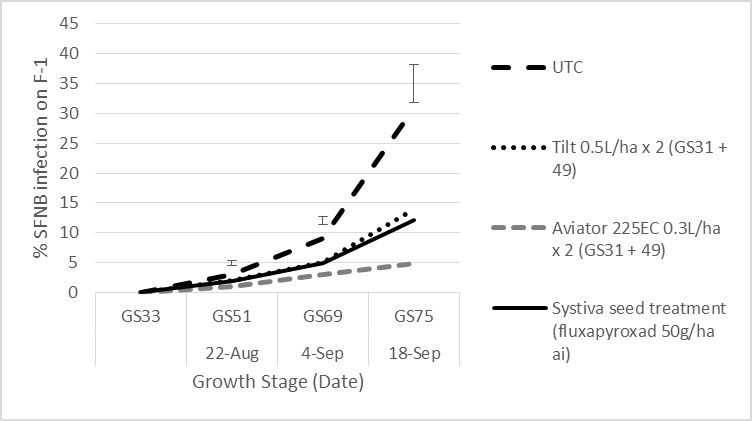
Figure 1. Spot form net blotch (SFNB) control using the new SDHI’s Fluxopyroxad (Systiva® seed treatment) and the new SDHI foliar fungicide active bixafen mixed with prothioconazole (Aviator Xpro 225EC®) compared to propiconazole applied as a foliar two spray programme in barley cv Hindmarsh – Meckering, WA 2013.
Yield performance and screenings in these trials correlated with disease control assessments (Figure 2), indicating that products containing new active ingredients offer us new and potentially alternative management tools for barley disease control.
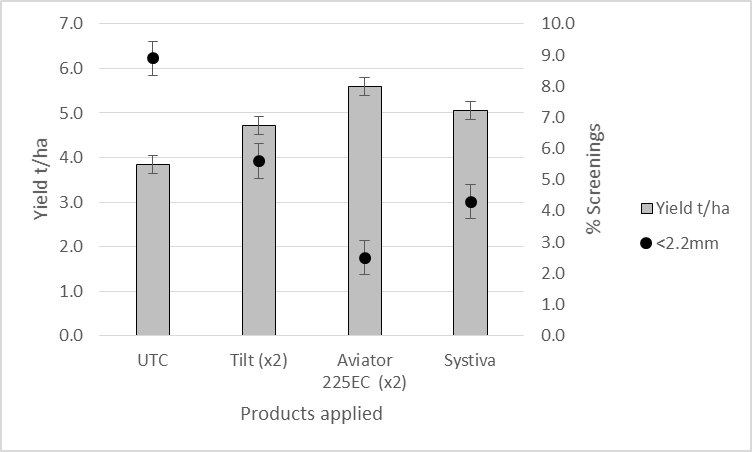
Figure 2. Influence of Spot form of net blotch (SFNB) control on barley yield and quality cv Hindmarsh – Meckering, WA 2013
Notes: Tilt 500ml/ha and Aviator Xpro 300ml/ha (currently undergoing registration & is not commercially available) were applied as foliar sprays twice at GS31 & GS49. Systiva was applied as a seed treatment alone and was not followed up with a later foliar fungicide.
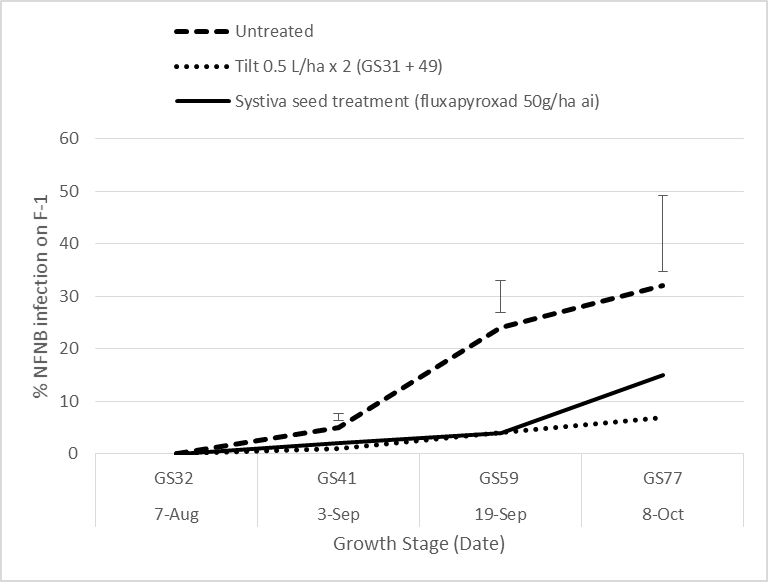
Figure 3. Net form net blotch (NFNB) control with Systiva® seed treatment versus a foliar two spray propiconazole (Tilt®) programme in barley cv Maritime – Ardrossan, SA 2013
A run of drier years in the northern region has produced fewer comparisons. One comparison run by BASF in 2015 at Tamworth has generated results that concur with research data produced further south and in the west. In a trial looking at four barley cultivars the SDHI seed treatments Systiva® and Vibrance® were tested with and without foliar follow ups. The results revealed useful data on the new fungicide performance as well as the timing for follow up fungicides (Figure 4). Yield responses to Systiva® applied alone averaged 0.25t/ha across the four cultivars when compared to the untreated (range 0.16 – 0.36t/ha).

Figure 4. Influence of SDHI seed treatments Systiva® and Vibrance® on barley yields – BASF Research site, Tamworth 2015 (data presented courtesy of BASF)
Adjustments to barley management strategies
The introduction of the fluxapyroxad active as the seed treatment Systiva® provides not only a new fungicide option but an opportunity to have an alternative fungicide strategy to a two spray foliar fungicide approach for susceptible cultivars or high risk rotation positions, such as barley on barley. The use of Systiva® in combination with foliar fungicides is likely to depend on the regional environment and rotation position, disease pressure and length of growing season.
Lower rainfall – shorter season environments
In shorter season environments with lower yield potential where disease pressure is reduced at later growth stages by warmer and drier conditions Systiva® is likely to be sufficient to give season long disease control where net blotch is the key disease. Under these circumstances whilst the products persistence will have dissipated by ear emergence, environmental conditions generally make follow up fungicides far less necessary.
Fungicide resistance risk with SDHI’s
SDHI’s are at a moderate to high risk of fungicide resistance. Ensure that they are not over used particularly as a seed treatment with no follow up foliar fungicide in successive years. Instead, consider using fungicides with a different mode of action in alternating seasons or as a follow up to the seed treatment in the same season.
Higher rainfall – longer season environments
In longer season scenarios of the HRZ, cooler temperatures and higher rainfall later in the spring typically create greater disease pressure later in the season and a need for greater fungicide persistence. In these scenarios Systiva seed treatment would need to have a follow up foliar fungicide at awn emergence (GS49) in susceptible cultivars and rotation positions. In addition, in the HRZ other diseases, such as barley leaf rust, can become more problematic in the second half of season and whilst Systiva has activity, it is not as effective against this disease. In these environments a follow up foliar fungicide should also be considered as an important resistance management tool to ensure the value of Systiva is maintained.
New fungicide performance in wheat
New fungicide active ingredients such as the SDHI’s will also have an impact on disease control in wheat as new fungicides become available, particularly against stubble borne diseases such as yellow leaf spot and Septoria tritici blotch (STB). The foliar fungicide mixture of bixafen and prothioconazole (not yet registered and proposed to be called Aviator Xpro®) has performed well in trials against both yellow leaf spot and STB (Figure 5a & 4b, 6a & 5b) in the GRDC funded New Actives field trials (CUR00019) lead by FAR. The data illustrates that a number of fungicide products labelled 1 (not named at this stage) applied in two spray programmes have given superior disease control to tebuconazole applied at the same timings.
|
|
|
Figure 5a & b. % Yellow leaf Spot infection on flag-1 28 days after two spray programmes of 14 different foliar fungicides and subsequent yield response – Yorke WA, cv Scout 2013
With dry finishes in southern Victoria yield responses to STB control has been variable (and are not presented) however there have been clear indications that a number of new fungicides show good promise for controlling STB including products such as epoxiconazole (Opus) which though registered for disease control in wheat does not have STB control on the label (Figure 6a & 6b).
|
|
|
Figure 6a & b. % STB infection on flag-2 26 & 27 days after two spray programmes of 14 different foliar fungicides and subsequent yield response – Westmere VIC, cv Espada 2013 & Inverleigh, VIC cv Revenue 2014.
Genetic resistance – APR genes are a key element of an IDM approach for stripe rust control
A key element of an integrated Disease Management approach is harnessing the value of genetic resistance. A GRDC funded project (FAR 00002) has been examining the value of Adult Plant Resistance (APR) genes for rust control when using newer generation fungicides, such as strobilurins and SDHI’s. The work conducted under the Australian Cereal Rust Control Programme (ACRCP) by FAR Australia & Sydney University at Cobbitty has indicated that Adult Plant Resistance (APR) genes both reduce the need for a second fungicide and gives greater flexibility in the timing of a single foliar fungicide. The research work which has compared fungicide programmes on commercial cultivars known to contain either one or two specific APR genes Yr18 and Yr29 has not been able to show significant advantages to newer generation fungicides over the triazole epoxiconazole.
With the wheat cultivar Corack (rated MS for stripe rust) protected by Yr29, despite higher levels of stripe rust earlier in the season the early fungicide at GS31 gave good protection of the lower canopy (Flag-3 and Flag-2) but did not prevent reinfection of the upper canopy (Flag & Flag-1). The lack of sufficient control in the upper canopy had a greater yield impact than the disease control achieved in the lower canopy, as a result a single flag leaf spray tended to be more effective than an early GS31 spray. However, to effectively control disease and maximise yield both GS31 and GS39 sprays were required (Figure 7).
Elmore CL Plus has greater resistance to stripe rust (rated MS-MR) and is protected by both Yr18 and Yr29. In this case there was less difference in yield between the GS31 and GS39 fungicide applications since later in the season the upper leaves of Elmore CL Plus appeared more able to protect themselves with the inherent genetic defence conferred by the APR genes. The consequence of this was that Elmore CL Plus showed less response to two fungicides over one and no significant yield differences between a single GS31 and GS39 fungicide timing (Figure 8).
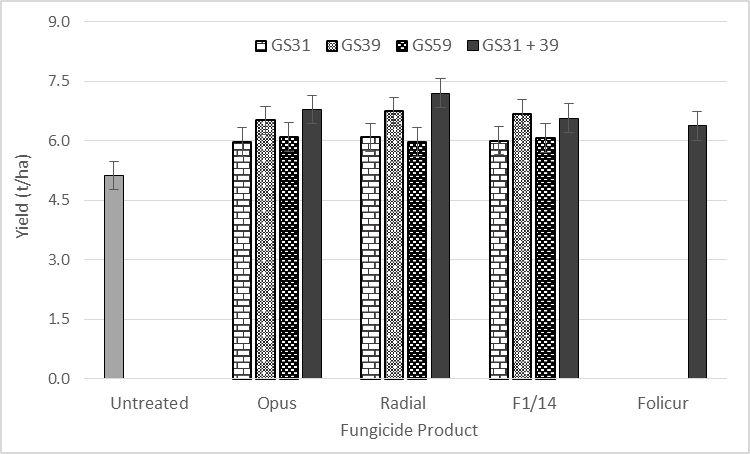
Figure 7. Influence of fungicide product and timing on grain yield (t/ha) of Corack under irrigation. – Cobbitty, NSW 2014
Opus - Epz – epoxiconazole
Radial - Epz + Az – epoxiconazole + azoxystrobin
F1/14 (experimental fungicide containing a SDHI)
Folicur - Tbz- Tebuconazole
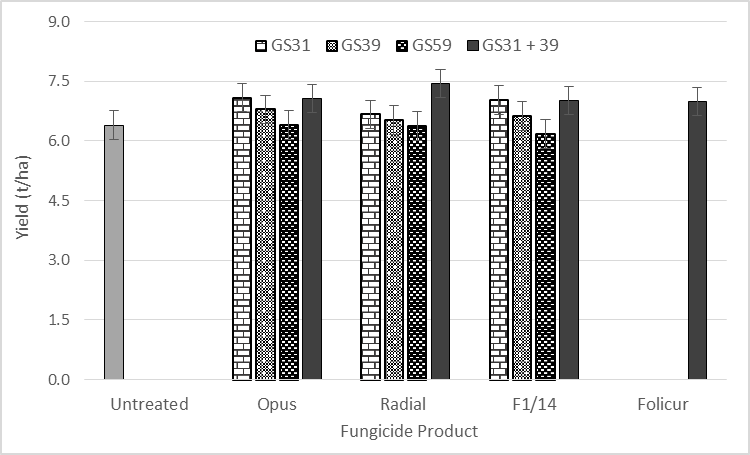
Figure 8. Influence of fungicide product and timing on grain yield (t/ha) of Elmore CL Plus under irrigation. – Cobbitty, NSW 2014.
Conclusions
New GRDC research being conducted on integrated disease management and new fungicides in conjunction with the agrichemical manufacturers shows great promise that will result in better disease management in Australian cereal and pulse crops. However, new products with new modes of action are not immune from resistance development. Therefore, to prolong their activity and that of our existing triazole products we need to use them judiciously and in combination with other control options.
N.B. Please note that reference to an agrichemical fungicide in this paper does not constitute a recommendation or that the active ingredient or product referenced carries an approval for control of a specific disease.
Acknowledgements
The research undertaken as part of this project is made possible by the significant contributions of growers through both trial cooperation and the support of the GRDC, the author would like to thank them for their continued support.
Contact details
Nick Poole23 High St, Inverleigh, VIC
Ph: 03 5265 1290
Fx: 03 5265 1601
Email: poolen@far.org.nz
GRDC Project Code: CUR 00019, CCDM/GRDC Program 9, FAR 00002,
Was this page helpful?
YOUR FEEDBACK



